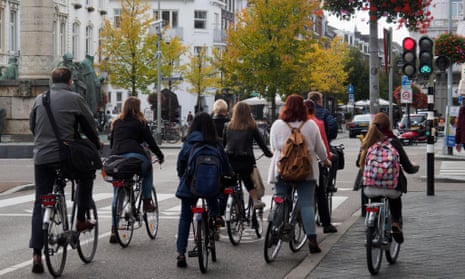In September 2012 the Google Street View car drove slowly along a road in Twickenham, London. It had to reverse when the driver found three wooden bollards blocking its way. The road was not a road at all, it was a cycleway. A cycleway built in – wait for it – 1937.
Originally surfaced with red concrete, the cycleway has faded to light pink but the granite kerbs are still in situ and, fooling the Street View navigation algorithms, it looks like a narrow road instead of the normal kind of “crap cycle lane” we are so unhappily used to in the UK.
The wide, protected cycleway beside the four-lane Chertsey Road is no freak. It’s one of 80 similar cycleways I discovered while researching the 1930s chapter for my forthcoming book, Bike Boom. Between 1934 and 1940, Britain’s Ministry of Transport would only give fat grants to road-building schemes if they included wide, protected cycleways on each side of the road. The MoT was aided in its cycle-friendliness by plans and guidance supplied by the Rijkwaterstaat, the ministry’s Dutch equivalent. Five hundred miles of such cycleways were planned; I’ve discovered that at least 280 miles of them were built.
Some are wholly or partially buried, while others are still used as cycleways but not commonly known to be 80 years old. And some – such as examples in Durham, Sunderland, Manchester and elsewhere – are hidden in plain sight, not listed by local authorities as cycleways.
Durham Road in Sunderland, for instance, has the sort of protection at a roundabout it is assumed only the Dutch can muster. The road has cycleways each side, but only one side is marked as a cycleway on official maps, and the roundabout side is not the one so marked. Not even the hive-mind has spotted it – this particular cycleway was built in 1938 yet it’s still waiting to be plotted on OpenCycleMap.
Postwar Ordnance Survey maps show that the 18-mile Southend Arterial Road from Gallows Corner in Romford to Southend once had cycleways along its full length (they were known as “cycle tracks” at the time) and this cycleway linked to others in the area. That’s right: before the second world war, Britain had an 18-mile kerb-protected intra-urban cycleway.
I’ve found these cycleways by digging – not in the ground, but in dusty archives, including poring over Ministry of Transport minutes held in the National Archives. And once I find a period source telling me a cycleway scheme once existed I use the spin-off from an American military mapping project to take a look at the location.
Google Street View is an off-shoot from Google Earth, the descendant of EarthViewer, a CIA-funded project that was used by the US military in war zones from the late 1990s onwards. Google acquired EarthViewer in 2004 and rebranded it as Google Earth in 2005. Archeologists often use Google Earth – and other open-access satellite-imagery services – to find hidden hill-forts and even buried treasure, but this is the first time the satellite and street-level imagery has been used to discover 1930s-era cycleways.
And now that I have found at least 80 such schemes I’ve partnered with an urban planner to bring at least some of them back to life. When I first told Urban Movement’s John Dales what I was up to he immediately recognised the potential of these forgotten cycleways. As he says in the above video, they are highly relevant today because the space for cycling that many planners and politicians say isn’t there is there.
We created a Kickstarter campaign and within three days it had exceeded its £7,000 target. Up to 420 backers have so far pledged £11,680. Reaching the initial target will enable us to research and perhaps revive a number of cycleways, but by no means all of them. We have until 25 May to get as many pledges as possible – the number of pledges could play an important later role when we start seeking the institutional funding required for national-scale cycleway improvements.
The sum raised is not a lot when you consider that remodelling one simple junction can sometimes cost £1m or more. The Kickstarter campaign will pay for the research work and the first plans to local authorities. After that our hope is to attract interest from today’s Department for Transport. And helpfully, the DfT now has quite the heartwarming backstory: long before modern cycle advocates were clamouring to “Go Dutch!”, the Ministry of Transport was actually doing it.

Comments (…)
Sign in or create your Guardian account to join the discussion